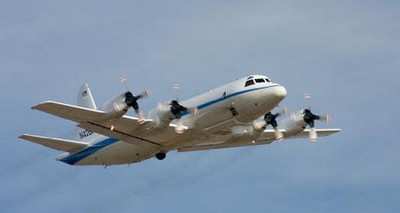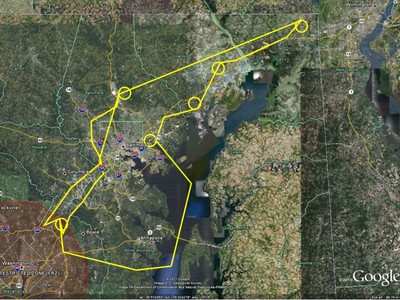P-3B Flights Will Supplement Satellite Data Over National
Capital Region
Two NASA research airplanes will fly over the
Baltimore-Washington region and northeast Maryland this summer as
part of a mission to enhance the capability of satellites to
measure ground-level air quality from space. The campaign is called
DISCOVER-AQ, which stands for Deriving Information on Surface
conditions from Column and Vertically Resolved Observations
Relevant to Air Quality. It is one of the five Earth Venture class
of investigations selected last year as part of NASA's Earth System
Science Pathfinder program. These targeted science investigations
complement NASA's larger research missions.

NASA P-3B
A fundamental challenge for spaceborne instruments monitoring
air quality is to distinguish between pollution high in the
atmosphere and pollution near the surface where people live. The
new NASA field campaign will make measurements from aircraft in
combination with ground-based observation sites to help scientists
better understand how to observe ground-level pollution from space
in the future. "What we're trying to do with DISCOVER-AQ is to fill
the knowledge gap that limits our ability to monitor air pollution
with satellites," said James Crawford, the mission's principal
investigator at NASA's Langley Research Center in Hampton, VA.
Since many countries, including the United States, have large
gaps in ground-based networks of air pollution monitors, experts
look to satellites to provide a more complete geographic
perspective on the distribution of pollutants. A fleet of
Earth-observing satellites, called the Afternoon Constellation or
"A-train" will pass over the DISCOVER-AQ study area each day in the
early afternoon. The satellites' data, especially from the Aqua and
Aura spacecraft, will give scientists the opportunity to compare
the view from space with that from the ground and aircraft.
"The A-Train satellites have been useful in giving us a broader
view of air pollution than has ever been seen," said Kenneth
Pickering, DISCOVER-AQ's project scientist at NASA's Goddard Space
Flight Center in Greenbelt, MD. "DISCOVER-AQ will help interpret
that data to improve air-quality analysis and regional air-quality
models."

Planned Air Pollution Research Flights
Initial test flights are planned for the week of June 27, with
up to 14 science flights starting as early as July 1. The P-3B will
carry nine instruments. The UC-12, essentially a King Air,
will carry two instruments. Sampling will focus on an area
extending from Beltsville, MD, to the northeastern corner of
Maryland in a pattern that follows major roadway traffic corridors.
The flight path passes over six ground measurement sites operated
by the Maryland Department of the Environment. The smaller aircraft
will collect data from as high as 26,000 feet. The plane's
instruments will look down at the surface, much like a satellite
instrument, and measure particulate and gaseous pollution.
NASA investigators will be joined in the air by colleagues from
the National Center for Atmospheric Research, the University of
California, Berkeley, and the University of Innsbruck in Austria.
The 117-foot P-3B will fly low-altitude spiral profiles over the
ground stations. These profiles will extend from 15,000 feet to as
low as 1,000 feet from the ground. The flights will sample air
along traffic corridors at low altitude between ground
stations.
The combined scientific resources are what make DISCOVER-AQ a
rare opportunity for air quality researchers. "One instrument is
not more important than another," said Jennifer Hains, a research
statistician with the Maryland Department of the Environment in
Baltimore. "The combination of all of them makes this campaign
valuable."
The DISCOVER-AQ flights are the beginning of a four-year
campaign that will bring NASA aircraft to Houston and other urban
regions. NASA's Langley center manages the Earth System Science
Pathfinder program for the agency's Science Mission Directorate in
Washington.
 ANN's Daily Aero-Linx (06.29.25)
ANN's Daily Aero-Linx (06.29.25) ANN's Daily Aero-Term (06.29.25): Gross Navigation Error (GNE)
ANN's Daily Aero-Term (06.29.25): Gross Navigation Error (GNE) Classic Aero-TV: Anticipating Futurespace - Blue Origin Visits Airventure 2017
Classic Aero-TV: Anticipating Futurespace - Blue Origin Visits Airventure 2017 NTSB Final Report: Cirrus SR22
NTSB Final Report: Cirrus SR22 Airborne Affordable Flyers 06.26.25: PA18 Upgrades, Delta Force, Rhinebeck
Airborne Affordable Flyers 06.26.25: PA18 Upgrades, Delta Force, Rhinebeck




